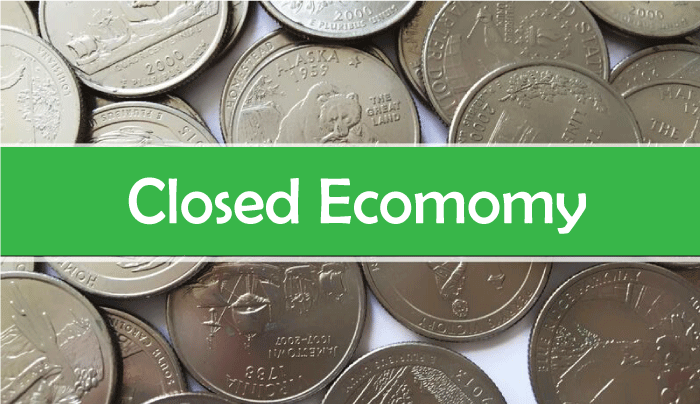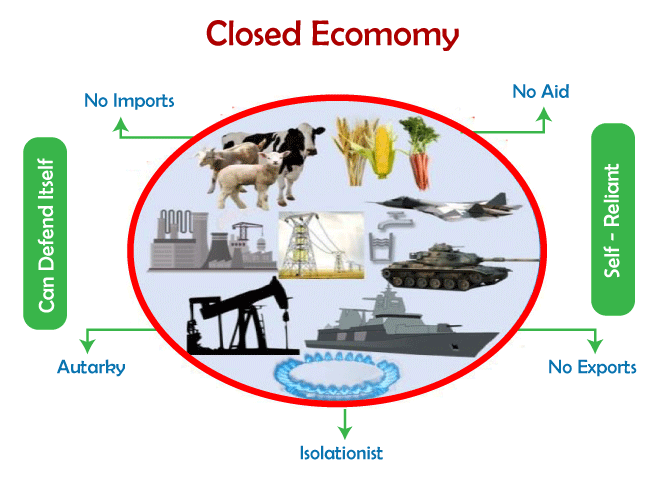What Is a Closed Economy and Why Are There None Today?A Closed Economy does not exchange goods and services with other economies. A closed economy is self-contained. There will be no imports and no commodities exiting the country. The closed Economy aims to provide domestic purchasers with the goods they require within the country's borders. There are cutoff thresholds for the accessibility of labour and products in a nation that is 'closed' to exchange. A closed economy is completely self-sufficient and does not advance foreign exchange. It protects domestic trading from foreign venturers. What is a Closed Economy?A closed economy is one in which no products or administrations are imported or exported since the Economy is self-sufficient and does not require any exchange action with economies outside the nation. Such an economy can meet all domestic customers' needs within the country's borders. A closed economy is one in which a country participates in no global exchange or competition. As a result, a diverse variety of labor and goods are given within the constraints of such an economy. A closed economy is equally slower than other economies since it only exchanges within the country. 
Meaning of Closed EconomyEven though closed economies are self-sufficient, they squander in unmistakable ways. Natural ingredients are essential for the production of goods in a closed economy. These natural compounds, which play an important role, are imported from other countries. This wastes money in the Economy. An administration may sometimes bar a certain industry from global trading through endowments, quantities, and taxes. No country has a completely closed economic system. There is no evidence that any country on Earth has a closed economy. Brazil has few imported goods compared to other countries on the Earth. As a result, Brazil might be considered a country with a nearly closed economy. Similarly, developing and maintaining a closed economy necessitates arduous effort and deliberation in tandem with globalization and the rise of innovation. Until 1991, India had a closed economy like many other countries. A country can't manage a closed economy. Natural substances are important in producing labour and goods in a country. The final result is determined by the raw materials used in the production. How does a Closed Economy Work?Working in entirely closed economies will be extremely difficult in general. Global tracing assists governments in comprehending and distributing diverse assets to various places where they are most effective. Countries may rapidly build their economies if they can offer goods with a low opportunity cost. They also produce when labour and products are less cost-effective for countries to produce. When all of the countries practice, it will have an impact on the entire world. One of the common scenarios is how many blue-collar jobs have shifted to China due to its lower cost of production. 
Along these lines, the manufacturing position in the United States has declined. In political judgement, the authorities may be obligated to conserve native positions and keep them from being uniformly reappropriated. These measures may reduce the interchange of multiple distinct countries. To create a completely closed economy, the government must boycott all international trade that occurs in a country. The country would then have to rely only on its usage and venture. With everything considered, it will be tough for a country to remain closed, as getting resources would be challenging. We all know that semiconductors are comprised of Silicon. However, not every country has a large silicon production. A country that does not have access to Silicon must import it from other countries like the United States, Russia, or China. Without the global interchange, the government would not approach Silicon, and so would not be able to give the final consequences such as smartphones, TVs, and PCs with semiconductors. Oil-producing countries are also critical in meeting the energy needs of other countries that lack oil resources. Along these lines, operating entirely closed economies is extremely difficult, if not impossible, in the sophisticated world. The Importance of a Closed EconomyWith globalization and global commerce, planning and maintaining a closed economy is impossible, because the open Economy has no restrictions on imports, it transmits the risk of relying heavily on them. Homegrown players cannot compete with international players. To address this, states could use norms, levies, and sponsorships. Asset accessibility varies and is rarely consistent over the world. As a result of this accessibility, a worldwide player will locate the greatest location to obtain a given asset and devise the best price. A closed Economy with globalization goals cannot produce a comparable product at a comparable price compared to Open Economy. As a result, the closed economy county will not compete with unfamiliar players. The government may need to use the above options to assist homegrown players and reduce reliance on imports. 
Reasons for the Closed EconomyThere are several reasons why a country may choose to have a closed economy or specific elements that will work with the support and operation of a closed economy. First and foremost, the Economy is considered self-sufficient, with no need for imports other than local lines to meet purchasers' wants.
Advantages of Closed Economy
Limitation of Closed Economy
Could a Closed Country Ever Grow?In simple terms, nations with closed economies develop, but not as rapidly as countries with open economies. A country with a closed economy has no imports or exports. The ultimate goal of a closed homegrown economy is to meet all of the requirements through homegrown creation. Fostering a closed economy is dependent on household use, commercial speculation, and so forth. Every single expense of production is sourced from within the country. Every interest in such economies relies on public reserve money without unusual capital inflows. It is extremely difficult to maintain a closed economy in today's culture. A closed economy contradicts cutting-edge financial theory. Global trade is a means to a flourishing economy. Sending is one of the energizers of a country's monetary progress. When commodities rise in value, domestic production rises. As a result, organizations create more jobs and pay more in the Economy. Each country may not have the resources required to deliver the items. Take, for example, the case of oil. Not every country on Earth has unrefined petroleum reserves. In a closed economy, product production is extremely limited in quantity and variety. People are motivated to consume what is available. GDP Equation for Closed EconomyGDP (Gross Domestic Product) represents the total monetary value of labour and goods provided within a country during a specific period or detailing cycle. Gross domestic product is proportional to the amount spent on four distinct areas. They are family area utilization, government expenditure, family area ventures, and net commodities (sends out short imports) by the outside area. In terms of money, earning a salary and spending money are considered the same. 
The GDP equation is as follows: GDP = Utilization + Speculation + Government Spending + Net Commodities GDP is calculated as utilization, speculation, and government expenditure. In this approach, Gross Domestic Product (GDP) develops in principle through the activities of these three categories. Example of a Closed EconomyIn practice, there are no completely closed economies. Brazil imports the least quantity of goods on the planet in terms of GDP and has the world's most closed Economy. Conversion scale appreciation and defensive exchange tactics are among the stumbling blocks that Brazilian firms face. Only Brazil's largest and most capable ventures with essential economies of scale can overcome send-out hindrances. Ukraine and Moldova (except late commodity areas), Morocco and Algeria (except oil agreements), Brazil (ignoring imports), and the majority of Africa, Tajikistan, and Vietnam are examples of nations having a partially closed economy (near the closed Economy). The Expansion of Open ExchangeWith a fresh attitude to innovation and countries developing in modernization, economies are shifting toward being open to global trade. For example, fuel is traded worldwide, and it is one of the unprocessed components that is commonly referenced. Countries that lack certain raw materials are consistently interested in them. Since roughly 2017, the United States, one of the world's largest oil producers, has imported approximately 10.4 million barrels per day. They trade with nations such as Canada, Saudi Arabia, Mexico, Venezuela, and Iraq. Also worth noting, according to World'sTopExport.com," an examination organization, the five biggest unrefined petroleum exporters totalled over USD 841.1 billion in items. Saudi Arabia has a market capitalization of $133.6 billion. Russia is worth $93.3 billion, Iraq is worth $61.5 billion, Canada is worth $54 billion, and the United Arab Emirates is worth $49.3 billion. These figures indicated the popularity of raw petroleum in 2017. ConclusionA closed economy, most certainly, reaps the benefits. Nonetheless, in today's environment, when the globe is becoming one, with the amount of globalization, reliance on assets, and innovation, it is impossible to build a closed economy. However, because it relies on imports, a completely open economy is extremely volatile. As a result, it is appropriate to create a hybrid of two economies in such a way that dependency is the government also supports modest and domestic players. The closed Economy cannot succeed at a time when the globe is merging into a single unit and globalization and technology are on the increase. A country cannot grow if its Economy is closed. Today, open and closed economies are hypothetical concepts; a country should react to both based on its current situation and overriding considerations. For an economy to grow, the government should plan a mixed economy that helps its domestic producers without exploiting its customers.
Next TopicInvestment Company Act of 1940
|
 For Videos Join Our Youtube Channel: Join Now
For Videos Join Our Youtube Channel: Join Now
Feedback
- Send your Feedback to [email protected]
Help Others, Please Share










